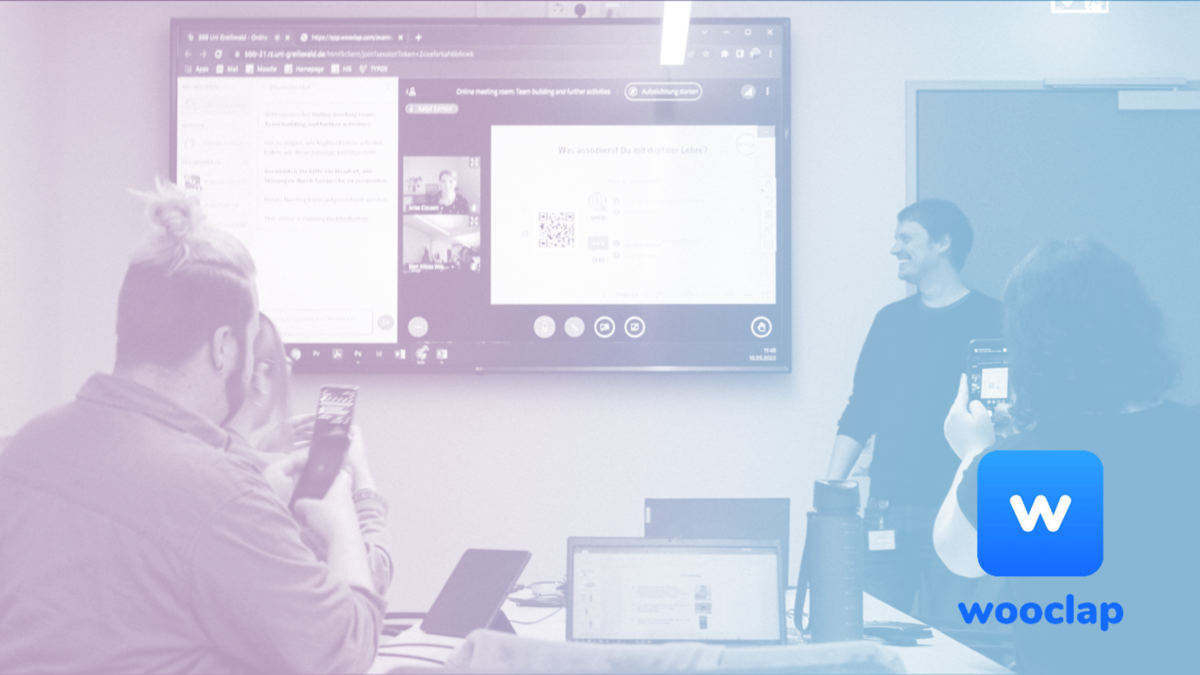Digitally Enriching Traditional Formats
Which class would you like to provide in a digital format?
In this overview, we show you what options you have as a lecturer when in-person events are not possible or you want to digitally enrich your teaching.
If possible, do not try to transfer your in-person teaching 1:1 to a digital format. This will fail in most cases because the conditions for communication and the attention span are quite different. For example, a 90-minute lecture is too long for a video. Shorten the content of teaching videos to essential information and shift the intensive discussion to the students' self-study phases by formulating specific work assignments.
Streaming a lecture
Video tutorial: Stream a lecture via the German Research Network (DFNconf Pexip) [01:36 min]
Streaming instructions from the University Computer Centre
Lecture
The traditional lecture format is mostly characterised by a 90-minute lecture held by a teacher. Sometimes experiments are shown or case studies demonstrated. The students are primarily in the receptive role and note down essential contents of the lecture.
Features:
Large amounts of input from the teacher
Hardly any interaction with students
Occasional questions from the audience are possible
It is primarily about knowledge transfer. Suitable purely digital formats:
Asynchronous teaching videos
Synchronous online lecture via video conferencing system (BigBlueButton or Zoom)
Synchronous streaming of the lecture (with accompanying chat) via DFNconf Pexip
Audio files or podcasts or
Learning modules with texts (e.g. Moodle "book" or "lesson") embedded in your Moodle course.
For any questions from the students, you can use, for example:
For interactions and enrichment with digital possibilities you can use, for example:
Interactions: Surveys, polls, short knowledge tests with Wooclap (synchronous)
Digital pinboard from TaskCards (synchronous)
Moodle course that has been matched to the teaching (asynchronous), e.g. to provide lecture material.
Seminar
Seminars are traditionally designed for participants to engage interactively with the knowledge elements and to acquire discursive and reflective competence in addition to analytical competence. Seminars are application-oriented, i.e. specific case studies are discussed and related to theoretical concepts. In some cases, empirical data is collected and analysed independently by the students. Typical teaching formats are student presentations, group work, and question-answer sequences.
It is primarily about student activation, i.e. the learners should (inter-)actively apply and think further about what they have learned. This can be implemented digitally as follows:
Collaborative work on tasks in the group forum
Collaborative work on a document with Etherpad
Collection of ideas on a digital pinboard on TaskCards
PDF annotation for joint reading of texts
Have students create quiz questions
Glossary to be created jointly by the students as a collection of e.g. technical terms
The following are suitable as means of student supervision, e.g. for arranging presentations and supervising group work:
Audio, video, commentary feedback on the submitted texts via the Moodle activity "assignment".
Etherpad for collaborative documents
Consultation hours and advisory sessions via the video conferencing system Jitsi
For group work, students can independently create a Zoom room (Zoom campus licence is also available for students)
For group work, students can use the Nextcloud as a point of sharing and for document storage
Practical & Tutorial
Practicals and tutorials accompany lectures or seminars. The focus is on the practical application of what has been learned. Various tasks are solved in the classroom using case studies in order to practise and consolidate the material from the corresponding course. The students get to know ways and strategies for solving problems.
Similar to the seminar, it is about student activation, i.e. the learners (inter-)actively apply and consolidate what they have learned. However, in contrast to seminars, practicals and tutorials often have a repetitive character.
Interactive videos with integrated questions and calls to action
Moodle activity "lesson" for theoretical (repetitive) input
Moodle activities with H5P, e.g. gap fill exercises, dictation, arithmetic quiz, crossword puzzle, picture puzzle etc.
Digital flashcards for consolidating terms or vocabulary (foreign languages), e.g. H5P Dialog Cards
Moodle activity "quiz"
Moodle activity "assignment"
Have students create question sets for tests and surveys
Peer feedback with Moodle activity "workshop"
The following are suitable for student supervision, e.g. for follow-up questions:
Audio, video, commentary feedback on the submitted texts via the Moodle activity "assignment"
Comments in TaskCards if task processing is done there
Etherpad for collaborative documents
Consultation hours and advisory sessions via the video conferencing system Jitsi
Online supervision & online consultation hours
Good supervision is essential for motivating learners and for the overall social relationship between teachers and students. A short question just before or after the class is not easily possible in the online-only format. Students need to know how and when they can reach you. Invest time in your virtual learning support concept. If students are meant to submit assignments online, you should also allow time to give them feedback on the assignments. You should also keep an eye on the communication in the forum and also play an active part yourself.
Digital tools for student supervision:
Email to all course participants
Message in Moodle to all course participants, groups or individual students
Forum in Moodle
Chat in Moodle
Consultation hours and advisory sessions via the video conferencing system Jitsi or BBB
Audio or video comments as feedback e.g. on submitted texts via the Moodle activity "assignment".
FAQs as glossary in Moodle for recurring questions
Group work
Learning in small groups (cooperative learning) brings many advantages, both in terms of learning and on a social level. This applies both to traditional teaching-learning settings in the seminar room and to online & digitally supported collaboration.
Basically, there are two forms of group work, which have different types of tasks. In collaborative work, all group members are given the same task. In principle, they could also solve them on their own, but collaboration facilitates the process. In cooperative work you divide an overall task into different individual tasks, each group member works on one of them. The students can only solve the overall task by cooperating and compiling the various partial solutions. The task must not over or underchallenge the students as a group, otherwise the chances of group work will be lost.
The following digital tools support group work:
For group work, students can independently create a Zoom room (Zoom campus licence is also available for students)
For group work, students can use the Nextcloud as a point of sharing and for document storage
In online seminars using BigBlueButton, teachers can create breakout rooms for group work
In Moodle, you can use the group mode to let students work or discuss matters separately, provide them with tailor-made materials or assign specific assignments and other activities
Grouping by the teacher: Assign participants to specific groups in the Moodle course according to individual criteria (e.g. semester, major,...).
Grouping by the students: The Moodle activity "Group choice" enables participants to register themselves independently in groups belonging to a Moodle course.
Grouping at random: In the settings of your Moodle course you will find the options "Create and assign groups automatically".
Peer feedback via Moodle activity "workshop" to enable students to give and take feedback from each other.
Self-study
At universities, the proportion of self-study is typically very high compared to the (online) contact time. In order to support students with this, you can use a wide variety of methods and digital tools, which can help, for example, with the active understanding of content, self-monitoring or the consolidation of knowledge.
Advantages of digital media in supporting self-study:
Digital learning material can encourage interaction and provide immediate feedback on the level of achievement, e.g. interactive graphics, knowledge quizzes or formative self-tests via Moodle quiz or H5P
Synchronous and asynchronous communication tools can be used to support self-study as needed, e.g. simultaneous work on a document via Nextcloud in combination with a video conference via BigBlueButton, Jitsi or Zoom or asynchronous working in Moodle Forum or via Etherpad
More sophisticated Moodle courses support self-directed learning, e.g. by permitting the choice of learning pathways via lesson or content via SCORM.
Digital learning materials, such as videos or podcasts, have a motivating effect on students and can be used specifically by teachers, for example to arouse interest at the beginning of a learning process. Letting students create such media themselves contributes both to the acquisition of content knowledge and to activation.
Learning materials (PDF files, scripts, links to videos or to further texts and websites) can be stored in the Moodle course as files or via link/URL
In addition to suitable work assignments, the following aspects are helpful for supporting guided self-study:
A clear structure: A clear time schedule and a comprehensible content structure
Content support: Encourage active engagement with the content through features such as guiding questions and interactive digital learning materials (glossary, Wiki, etc.)
Feedback in both directions: Feedback on solutions to tasks motivates and acknowledges students. In large groups, peer feedback can also be given via "peer assessment", or student problem solving, questions and feedback can be taken up in the in-person teaching, which is thus linked to the self-learning phases. Good teaching practice shows that teachers should also seek feedback from students to assess how their efforts are received by learners and whether they are truly supportive.
When planning suitable tasks and forms of support for self-study, teachers can seek guidance from the concept of Constructive Alignment, which suggests it is not only wise to define the learning objectives when planning a course, but also to specify the forms of assessment in order to be able to assess whether the learning objectives have actually been achieved and which learning activities contribute towards the acquisition of envisaged competences.













